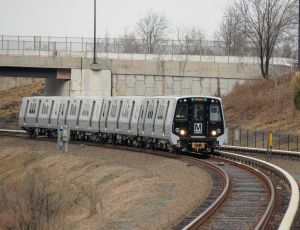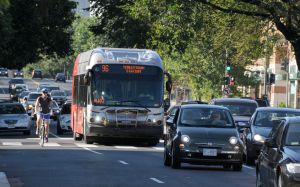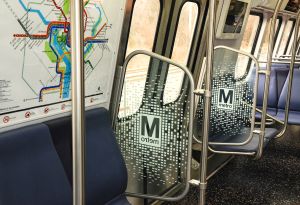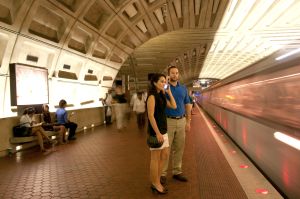Restoring Pride in the National Capital Region's Public Transit System
by Paul J. Wiedefeld, General Manager/CEO
March 6, 2016
While Metro has new leadership, the Authority's mission is unchanged - to operate and maintain a safe, reliable and effective transit system that enhances mobility, improves the quality of life, and stimulates economic development in the Washington metropolitan area.
To achieve that mission, Metro must improve safety and security, deliver more reliable service, and continue reforms to get our financial house in order.
As I listen to riders, advocates, employees, business and community leaders, elected officials, funding partners, regulators, railroad experts, and management consultants, the message for Metro is clear - restore trust in safety, make the trains and buses run on time, and manage effectively and efficiently as stewards of customer fares and public assets.
What's equally clear 90 days in, is that turning Metro around requires us to confront some hard truths.
Hard truths
The safety culture at Metro is not integrated with operations, nor well-rooted at all levels. Understandably, high-profile incidents have shaken
 confidence in the operational safety of the rail system and corrective actions are needed. And, while crime on Metro remains lower than in most communities, recent assaults have alarmed customers who deserve to be reassured by active policing strategies.
confidence in the operational safety of the rail system and corrective actions are needed. And, while crime on Metro remains lower than in most communities, recent assaults have alarmed customers who deserve to be reassured by active policing strategies.
While riders told me they want to feel safe, the top issue they point to is service reliability. Last year, rail on-time performance fell from 92% to 85%, and the experience for many customers was even worse as rail car mechanical failures have doubled the number of late trains. Once in service, mechanical issues with doors, brakes, and propulsion systems result in customer offloads when the trains can't complete their runs. Inadequate supply chain for parts, maintenance practices, and modern fleet management strategies are also lacking.
Both planned and unscheduled track work compound customer frustrations on weekdays and weekends. Metro's approach has been to maintain some level of service during middays and weekends, which has proven to be unpredictable for riders.
Capital projects lack proper management and predictability for riders, with transparent scopes, cost estimates, and schedules. The Capital program has been significantly underspent every year for more than 10 years. The reality is, Metro's $1.1 billion program will only realistically spend about $950 million next year. Without shifting priorities away from a single safety project, resources must be clearly and candidly aligned with project schedules.
 Other financial reforms have to be made on the operating side, as cost recovery declined from 47% in 2011 to 45% today, due mostly to rail fare box revenue slowing while operating costs grew. But with a growth in headcount, combined with fewer hours worked per employee, Metro is doing less with more. In nearly 10 years there have been no significant reductions in force, resulting in redundant positions among back-office staff that will be abolished through attrition where possible.
Other financial reforms have to be made on the operating side, as cost recovery declined from 47% in 2011 to 45% today, due mostly to rail fare box revenue slowing while operating costs grew. But with a growth in headcount, combined with fewer hours worked per employee, Metro is doing less with more. In nearly 10 years there have been no significant reductions in force, resulting in redundant positions among back-office staff that will be abolished through attrition where possible.
Metro's financial position today is stable with expenses better managed, and the agency's cashflow is positive. But financial systems are substandard compared to other transit authorities and require enormous efforts to modernize. Only through continued improvements in these systems can Metro produce timely financial reporting and clean audits.
In the long term, Metro must address a persistent structural deficit. To continue balancing its budget, Metro would require a combination of operating subsidies and passenger fare increases of about 6% annually over the next 10 years just to keep pace with cost growth for existing service levels. Like other transit systems, cost escalation is driven primarily (73%) by personnel expenses to operate, maintain and manage bus and rail services. Unlike other regions' transit systems, Metro has no clearly defined multi-year operational funding plan. As a region, this issue needs to be addressed head-on to meet both today's issues and to support future economic growth for the region.
Finally, Metro must be restructured for management success. Organizational span of control is too large, too many vertical silos remain, and staffing is not mission focused or aligned in key priority areas, most importantly, the customer experience.
A restructuring that starts with the executive team will improve accountability and efficiency, as well as restore a business-like approach that devolved over time to be more about turf than delivering results for customers. None of this, however, explains a five-year slide in rail ridership, which requires more in-depth analysis to fully understand.
Going Forward to Better Serve Customers
It will take everyone going forward together - employees, management, our Board, riders, funders, business leaders, communities, and all stakeholders - to restore this once-great system, renew our collective pride, and deliver a world-class system that benefits the nation's capital.
Metro isn't just rail. It includes bus and paratransit services that are part of an integrated, intermodal network, and it must recognize opportunities to partner with the private sector and other regional providers. We will test those opportunities in parking and paratransit, where good customer service and better amenities might be offered more cost effectively in some areas.
 While acknowledging that rapid change is needed throughout the Authority, success depends on setting priorities and developing immediate, midterm, and longer range horizons with a realistic change schedule so that the organization's full focus can be brought to bear on issues in order of importance. To begin the change, Metro is undertaking a portfolio of initiatives that, in the near term, deliver fundamentals in key areas to regain trust from riders and local governments. In the mid-term, the actions build on the stronger foundation to achieve best in class status in the U.S. This includes not only work internally, but partnering with regional thought leaders on governance and funding. And, while working on long-term initiatives such as Silver Line phase two, Metro will look to innovation and new technologies that put this region in league with some of the world's best transit systems.
While acknowledging that rapid change is needed throughout the Authority, success depends on setting priorities and developing immediate, midterm, and longer range horizons with a realistic change schedule so that the organization's full focus can be brought to bear on issues in order of importance. To begin the change, Metro is undertaking a portfolio of initiatives that, in the near term, deliver fundamentals in key areas to regain trust from riders and local governments. In the mid-term, the actions build on the stronger foundation to achieve best in class status in the U.S. This includes not only work internally, but partnering with regional thought leaders on governance and funding. And, while working on long-term initiatives such as Silver Line phase two, Metro will look to innovation and new technologies that put this region in league with some of the world's best transit systems.
To restore public confidence, initiatives will be transparent, and progress will be made visible. Stakeholders will be able to track progress through the Customer Accountability Report (CARe), an online tool to understand and monitor Metro's actions. The aim of CARe is to be more transparent as an agency and increase overall stakeholder confidence in the areas of safety, service reliability and fiscal accountability. As specific actions are developed, funded, and scheduled, they will be added to the inventory. An initial set of actions has been developed to begin the process of improving safety, service reliability and fiscal management.
Here are a few priority areas that Metro is tackling as a beginning:
Improve safety and security, and restore public trust

- Recruit a new Chief Safety Officer (CSO) to lead day-to-day safety culture change.
- Begin installing new Metro and public safety radio systems, including cabling for cell phone service in tunnels.
- Activate an online schedule with frequent updates when each tunnel segment will be available for telecom providers to offer cell phone service.
- Create dynamic digital reports with detailed actions being taken to meet all National Transportation Safety Board (NTSB) and Federal Transit Administration (FTA) Safety recommendations.
- Increase the number of police officers in the rail and bus system.
Improve reliability and win back riders
- Publish and implement a rail service reliability plan to reduce excess waiting time and crowding, ensuring that trains are arriving as
 scheduled.
scheduled. - Develop a "get well" plan for rail cars that reduces delays and offloads by ensuring trains experience far fewer mechanical failures once in service.
- Accelerate delivery of new 7000-series rail cars.
- Develop and publish a track quality improvement program to provide a safer train ride and reduce delays. Include a third-party review to ensure customer inconvenience is minimized and track work predictability improves.
- Clearly communicate status of track and rail infrastructure maintenance, indicating what remains of backlogged projects and state of good repair work with schedules that are less adverse to the customer's experience.
- Establish management "ownership" of each rail line to improve the customer's experience.
- Strategically position platform attendants to assist customers in key transfer stations during peak travel.
- Improve station environments for customers with schedules of improvements that are updated frequently to show status of lighting, signage, and other key improvements.
- Develop a mobile "app" that provides customers easier access to train and bus departures, trip planning, and other information on demand.
- Improve customer complaint resolution through social media.
- Test new pass products that give customers opportunities to save money
while riding Metro. - Examine opportunities to simplify fares.
- Establish accountability for all - annual performance evaluations for every employee at every level.
- Partner with regional and state departments of transportation to introduce traffic signal prioritization in key bus corridors to reduce travel times.
- Improve bus and Metro Access reliability through continued introduction of new vehicles.
Alter fiscal trajectory and renew jurisdictional confidence

- Deliver a timely audit for FY16.
- Reduce back-office costs and redundant positions.
- Continue to develop financial management systems to deliver better business information, improve reporting, and inform decision making.
- Develop a framework for collective bargaining agreements that respects the workforce, is more responsive to customers, and delivers enhanced cost efficiencies.
- Improve case management to reduce worker compensation costs.
- Reduce overhead costs through public-private partnerships for select paratransit trips, parking management, and other opportunities.
- Realign delivery of capital projects to deliver better, faster improvements for riders. Publish major capital projects online and routinely update status.
- Publish all actions taken to satisfy FTA Financial Management Oversight recommendations.
- Conduct cost-benefit analysis regarding sale of Metro headquarters building.
Next steps
These priorities are the first in a portfolio of initiatives that are being undertaken to deliver the basics of better service. Actions will be taken in every department as part of Metro's business plan to make these initiatives successful and to ensure accountability. Some initiatives will be experimental and will only be pursued if they prove successful. Others will be fine-tuned as we learn.
Plans and progress will be communicated frequently throughout Metro, and every employee will be held accountable through specific and measurable goals. As part of Metro's commitment to transparency, at the end of each year, Metro will enhance accountability by posting results of CARe actions and related performance by major departments.
Taken together, in time these actions will improve Metro safety and security, deliver more reliable service and improve financial management. What these actions do not address, however, are the unrelenting foundational issues of funding and governance identified by virtually every Metro stakeholder. Those matters, including the structural deficit in Metro's operating budget, are properly being considered by the Board of Directors and funding jurisdictions. I look forward to supporting their efforts towards improving Metro for the entire region.